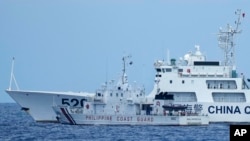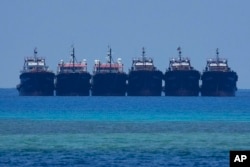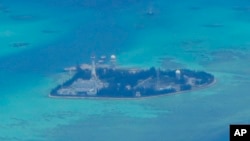The topic of China’s increasing assertive activities in the South China Sea, from harassing vessels and building structures to introducing a new map with sweeping territorial claims, was prominent at the annual ASEAN Summit in Jakarta last week.
But ASEAN, the bloc of 10 Southeast Asian nations that operates on the principle of consensus and noninterference of sovereignty, continued to be divided over dealing with China’s aggressive behavior in the disputed waters and seeking support from non-ASEAN partners, experts say.
“ASEAN’s disunity on Chinese assertiveness in the South China Sea has been on display for over a decade after Cambodia, as ASEAN chair in 2012, refused to include a reference in the Chairman’s Statement,” Carl Thayer, professor emeritus of politics at the University of New South Wales Canberra, said in an email to VOA Khmer.
Thayer said that although Indonesia, which is this year’s chair, mentioned in the Chairman’s Statement that some ASEAN members expressed concerns about Beijing’s land reclamations in the South China Sea, military activities and serious incidents in the area, “there is nothing ASEAN can do collectively to alter the ‘facts on the ground’ except name and shame China.”
“China can easily exert pressure on ASEAN member states to prevent consensus forming to take more assertive action,” he said. ”China could use punitive economic sanctions against any country that attempted to stand up to China.”
Yulius Hermawan, a lecturer on international relations at Parahyangan Catholic University in Bandung, Indonesia, told VOA Khmer in an email it is worrying that ASEAN leaders failed to show a united response to China, which “may reflect a high degree of China's ability to steer ASEAN as a regional bloc.”
“ASEAN leaders whose countries are not engaged directly in the conflict, including Indonesia, have been apparently very careful in addressing the issue of [the] South China Sea for the sake of their economic interests,” said Hermawan.
“They kept silent, even when their fellow ASEAN members raised their open harsh protests against China's rude action in their territories,” he said.
A revised map
In July, China and ASEAN agreed on a series of guidelines to conclude a nonaggression pact aimed at preventing conflicts in the contested waters.
China, however, has dragged its feet on an agreement that would limit its action with increasing assertiveness in the disputed territory.
On August 28, Beijing published a new version of its national map asserting possession over nearly the entire waters, drawing strong protests from its neighbors, according to The Associated Press.
China dismissed the complaints.
Chinese Foreign Ministry spokesperson Wang Wenbin said the revisions of the map were a “routine exercise of sovereignty in accordance with the law.”
“We hope relevant sides can stay objective and calm, and refrain from overinterpreting the issue,” he said during a daily press briefing on August 30.
Divided response
ASEAN remains divided over how to respond to China’s territorial claims in the disputed waters.
Among ASEAN member states, the Philippines, Vietnam, Malaysia and Brunei are official claimants against China.
They failed to bring the other six members — Cambodia, Indonesia, Laos, Myanmar, Singapore and Thailand — on board to collectively and assertively address the South China Sea disputes in a joint statement as the summit wrapped up Thursday.
Myanmar has not been invited to the summit since the military seized power in February 2021.
John Ciorciari, associate professor of public policy at the University of Michigan, said in an email to VOA Khmer that ASEAN remains an important forum for diplomacy, but “without consensus on some of the region’s most pressing challenges, it has little weight as a collective entity.”
“ASEAN members keen to resist China’s maritime advances must look elsewhere for support,” he said.
Ciorciari said individual ASEAN claimants can forge more fluid diplomatic and strategic coalitions, drawing in external actors, including the Quad. Formed by the United States, India, Australia and Japan, the Quad’s primary objectives are to work for a free, open, prosperous and inclusive Indo-Pacific region, according to a joint statement issued by Prime Minister Anthony Albanese of Australia, Prime Minister Narendra Modi of India, Prime Minister Fumio Kishida of Japan and President Joe Biden of the United States in May 2022.
“This entails considerable risk, but the alternative paths of relying on ASEAN and bilateral diplomacy are clearly a recipe for continued Chinese encroachment,” Ciorciari said.
‘New cold war’
China’s sweeping claims over most of the South China Sea, a resource-rich territory and important global trade corridor, have angered the four ASEAN claimant states.
Chinese Premier Li Qiang spoke at the summit with ASEAN member states plus Japan, South Korea and China, saying countries needed to "appropriately handle differences and disputes.”
"At present, it is very important to oppose taking sides, bloc confrontation and a new cold war," Li told the meeting.
The new cold war rhetoric, experts said, was Beijing’s effort to prevent Southeast Asian nations from bringing powerful external actors into the South China Sea conflicts.
“China’s new cold war rhetoric plays into ASEAN states’ proclivity to pursue a policy of nonalignment rather than take sides. Instead of openly opposing China, most ASEAN states would prefer to stand back and urge dialogue and peaceful means to South China Sea protagonists,” Thayer, of the University of New South Wales Canberra, said.
“China’s references to a new cold war carry an implicit threat, suggesting that Southeast Asian states will face costs if they side with the United States,” Ciorciari, of the University of Michigan, said.
US presence
Aware of the prospect for renewed fissures and proxy conflicts in the region, the Southeast Asian bloc also held broader meetings with Li, leaders of regional partners including Japan, South Korea, Australia and India, as well as U.S. Vice President Kamala Harris.
According to a White House readout, Harris said the United States is “committed to the Indo-Pacific and ASEAN centrality,” and “emphasized that freedom of navigation and overflight must be respected in the East China Sea and South China Sea.”
The U.S. has no territorial claim over the contested South China Sea but has asserted that freedom of navigation and flight, as well as peacefully resolving disputes, are in its national interest.
There are an estimated 11 billion barrels of untapped oil and 190 trillion cubic feet of natural gas below the waters of the South China Sea, according to the U.S. Energy Information Administration. Goods worth an estimated $3 trillion to $5 trillion are shipped through the South China Sea every year, amounting to something like a third of the world’s trade, according to the United Nations and other sources. And more than half of the world’s fishing vessels operate in these resource-rich waters, according to the BBC.
Sun Narin of VOA Khmer provided additional reporting from Jakarta, Indonesia.









